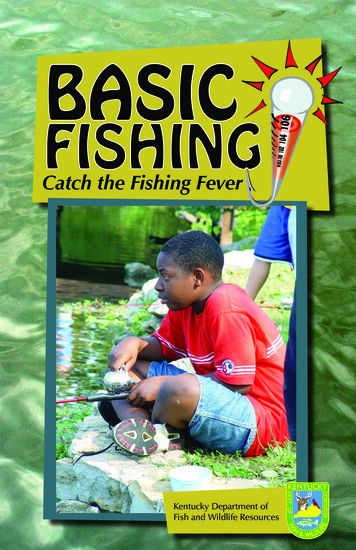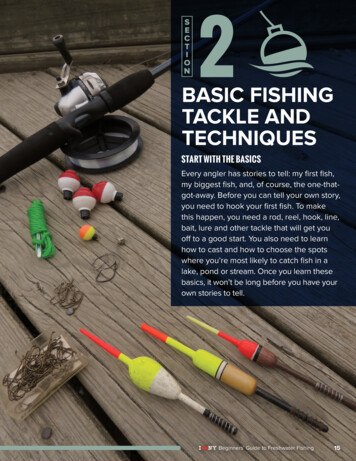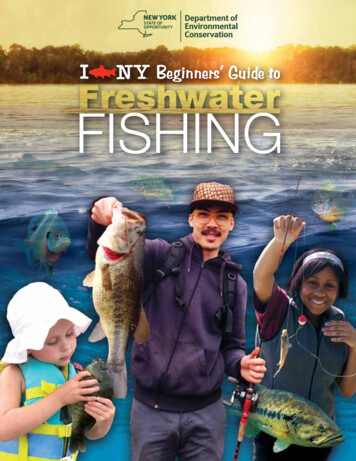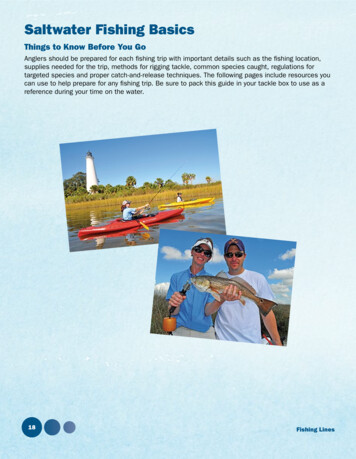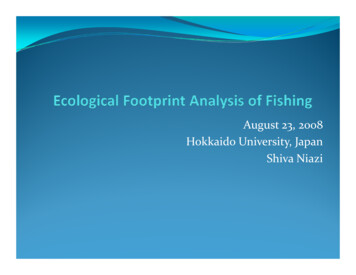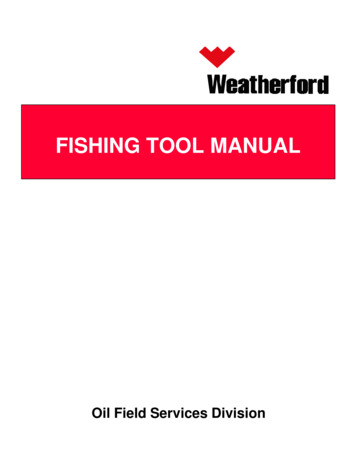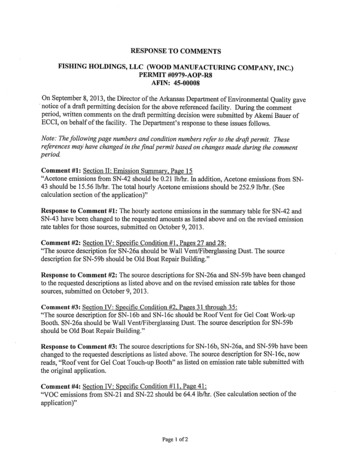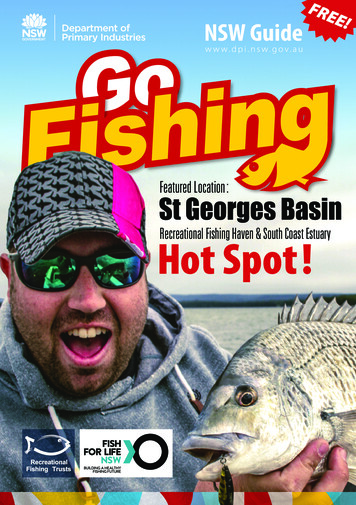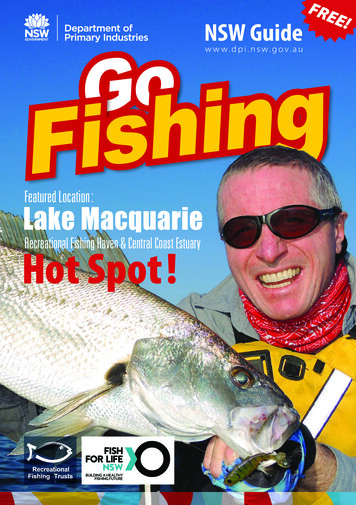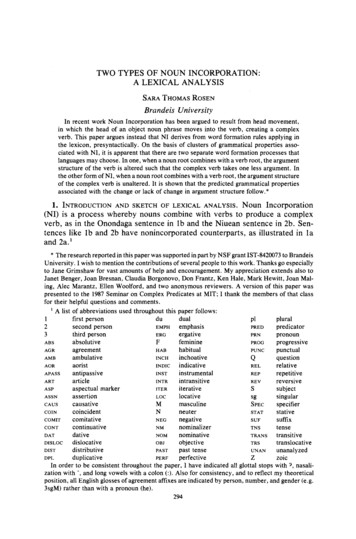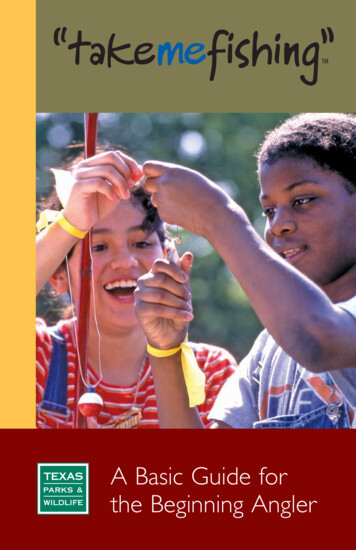
Transcription
A Basic Guide forthe Beginning Angler
WELCOME TO FISHING IN TEXAS!Learning to fish can be as simple as tying your shoe. You may find yourselfsitting on the bank of a river or pond using a cane pole and a can of worms,or using a fully-rigged boat with state-of-the-art equipment. Either way,with some basic knowledge and a minimum of skill, a beginning angler canembark on a lifetime of fun, relaxation, and camaraderie with other anglers.In the next few pages, we’ll discuss several styles of fishing, types of rods,reels, knots, baits, lures, fresh and saltwater fish, and aquatic habitats. You’llfind tips to improve your skills and what you can use to have a fun, exciting,and successful fishing trip. You’ll also learn how you can help protect ourstate’s precious aquatic resources.And don’t forget – fishing isn’t just about catching fish! As experiencedanglers will tell you, fishing is one of the best ways families and friends relaxtogether as they enjoy being outdoors and learning new skills.
A Basic Guide for the Beginning AnglerTABLE OF CONTENTS1Basic Fishing Tackle.2Fishing Rods.3Fishing Reels.5Casting Tips.6Knot Tying. 12Natural and Live Baits. 14Lures. 17What Goes in the Tackle Box. 20Freshwater Fish. 22Saltwater Fish. 23Fishing in Texas Farm Ponds. 24Fishing in Hill Country Streams. 26Fishing in East and West Texas Streams. 28Fishing in Reservoirs. 30Fishing in Coastal Bays and Marshes. 32Finding Good Fishing Spots. 34How to Handle Fish. 36How to Clean Fish. 38Fishing Safety. 40Fishing Ethics. 41Fishing Regulations. 42Invasive Species. 45More Information. 46Map of Parks That Have Fishing. 48
A Basic Guide for the Beginning AnglerBASIC FISHING TACKLE2HooksHooks come in an assortment of sizes and styles and must be kept sharpto be effective. If you plan to release your catch, bend down the barbto make it easier to remove the hook. Choose the size of hook for thespecies of fish you are trying to catch and the type of bait you are using.Ask a seasoned angler or a bait and tackle dealer for suggestions.LineFishing line comes in pound-test, (the line size or strength). The largerthe line size the stronger it is. Six-pound test line is more flexible but isnot as strong as 12-pound test line. Match your fishing line to your rodand reel capability and the species of fish you want to catch. Usingheavier line or higher pound test than needed may reduce the numberof hits or strikes you get because heavier line is more visible to fish.SinkersSinkers are weights used to cast your bait, take bait to the bottom, holdbait in place, or keep your bobber upright. Sinkers are designed in severaldifferent shapes and sizes and are used for various types of fishing techniques. They range in size from BB split shot to five pounds, somethingshort of a cannon ball. In many cases, you will place your sinker 4 to8 inches above your hook to allow live bait to look natural to the fish.BobbersBobbers, floats and corks are used for three reasons. They keep yourbait where the fish are biting, keep bait off the bottom, and they tell youwhen you’re getting a bite or strike by bobbing up and down. Bobberscome in various shapes from round, to pencil or quill, to popping, andoblong. Most bobbers are spring-loaded and attach to your fishing linewith a clip. Some are tied directly to your line or allow the line to slipentirely through for slip-cork fishing.
A Basic Guide for the Beginning AnglerFISHING RODS3Rods come in several varieties, each with its own advantages. Choosing a rod isa personal choice. You can fish with a can and string or a fancy rod and reel.One of the simplest and easiest fishing rods is the cane pole.Cane PolesCane poles are simply a pole or straight rod with a fishing line tied on toit. Use cane poles mainly for shoreline fishing since you’re restricted todepth and distance you can reach. Cane poles can be made of bamboo,fiberglass, graphite or even a straight tree branch. Cane poles work, areeasy to use and are inexpensive.PISTOL GRIP OR STRAIGHT HANDLELINE GUIDES ON TOPSpincasting and Baitcasting RodsCasting rods have “spincast” or “baitcast” reels and line guides mountedon top. Spincasting rods are easy to handle and perfect for beginners.These rods have straight handles and small line guides. Spincast tackle isthe most popular. Baitcasting rods have either a pistol-grip or straighthandle. The baitcast rod with its more complex reel is more difficult tocontrol and is better suited for an experienced angler.
A Basic Guide for the Beginning AnglerFISHING RODS4Spinning RodsSTRAIGHT HANDLE, LINE GUIDES ON BOTTOMSpinning rods have straight handles with large line guides and reelsmounted on the bottom. Spinning reels cast quickly and long distances,making this rod suitable for all types of freshwater and saltwater fishing.Fly RodsLONG FLEXIBLE ROD, LINE GUIDES ON BOTTOMFly rods are very long, flexible rods. In flyfishing, you cast the line, not thelure. You’ll see anglers develop almost artistic casting techniques, addingto the appeal of the sport. Line guides and reel are mounted on bottomof the rod. Fly rods come in various weight classes and lengths, suited fordifferent locations and fish.Saltwater TackleGoing after saltwater fish involves a little changein the strength of the equipment. The rods,reels, hooks, line and lures or baits vary just as infreshwater fishing, but they can be stronger andheavier, built to withstand larger fish and naturalor artificial structures.
A Basic Guide for the Beginning AnglerFISHING REELS5SpincastThis popular reel is ideal for beginners.Known as a “closed-faced reel,” it’s theeasiest reel to use.SpinningThis “open-face reel” mounts under therod. Fishing line spools off quickly allowing longer casts. This reel is able to castlighter baits and lures.BaitcastBaitcast tackle is suitable for all types offish and fishing. The spool turns whenyou cast, however, and can entangle theline if not properly adjusted. You’ll needto practice with this model.Fly reelThe fly reel is designed to allow fluidmovement of the fishing line. This reel ismounted on the bottom of the rod.
A Basic Guide for the Beginning AnglerCASTING TIPS6SpincastingA spincasting reel has a button that you push with your thumb to releasethe line.1.Grasp the rod’s handle or pistol grip with one hand. Push the reel’sthumb button down and hold it in.2.Face the target area with your body turned to a slight angle, abouta quarter turn. Aim the rod tip toward the target, about level withyour eyes.3.Swiftly and smoothly bend your arm at the elbow, raising your handwith the rod until it almost reaches eye level. When the rod isalmost straight up and down, it will be bent back by the weight of thepractice plug. As the rod bends, move your forearm forward with aslight wrist movement.4.When the rod reaches eye level, release the thumb button.If the plug landed close in front of you, you released the thumb button toolate. If the plug went more or less straight up, you released the thumb buttontoo soon.
A Basic Guide for the Beginning AnglerCASTING TIPS7SPINCASTING1234
A Basic Guide for the Beginning AnglerCASTING TIPS8SpinningWith a spinning reel, you use your finger to release the line.1.Grasp the rod’s handle, placing the reel “stem” that attaches the reelto the rod between your middle fingers. Extend your forefinger totouch the spool cover. Open the reel’s bail with your other hand.2.Face the target area with your body turned at a slight angle, about aquarter turn. The arm holding the rod handle should be closest tothe target. Aim the rod tip toward the target at about eye level.3.Swiftly and smoothly, using just one motion, bend your casting arm atthe elbow and raise your forearm so that your hand is almost at eyelevel.4.When the rod is almost straight up and down, it will be bent by theweight of the practice plug. As the rod bends, move your forearmforward with a slight wrist movement.5.When the rod reaches eye level, straighten your forefinger to releasethe line.If the plug landed close in front of you, you straightened out your index fingerto release the line too late. If the plug went more or less straight up or behindyou, you straightened your index finger too soon.
A Basic Guide for the Beginning AnglerCASTING TIPS9SPINNING12345
A Basic Guide for the Beginning AnglerCASTING TIPS10BaitcastingThe baitcasting reel has a button either on the top right-hand side of thereel or a “thumb” button behind and center of the spool that you pushwith your thumb to release the line.1.Grasp the rod’s pistol grip or handle with one hand. Push the reel’sthumb button down and move your thumb on the spool. Release theline so that the casting plug falls to the ground. Adjust the spooltension knob (located on the side of the reel) so that the spool stopshen the plug hits the ground. It may take a couple of times toaccomplish this and adjust it correctly. This will reduce the reel frombacklashing when cast. Backlashing occurs when momentum fromthe cast allows the spool to keep rotating causing line to ball up oncethe plug hits the water or ground.2.Face the target area with body turned at a slight angle, about aquarter turn. Aim the rod tip toward the target, about level withyour eyes.3.Swiftly and smoothly bend your arm at the elbow, raising your handwith the rod until it almost reaches eye level. When the rod is almoststraight up and down, it will be bent back by the weight of the practice plug. As the rod bends, move your forearm forward with aslight wrist movement.4.When the rod reaches eye level, release your thumb off the spool.As the practice plug hits the ground, place your thumb back on thespool to reduce backlash.If the plug landed close in front of you, you released your thumb too late.If the plug went more or less straight up, you release your thumb too soon.
A Basic Guide for the Beginning AnglerCASTING TIPS11BAITCASTING1234
A Basic Guide for the Beginning AnglerKNOT TYING12Arbor KnotQuick, easy connection for attachingline to the reel spool.1.2.3.4.Pass the line around the reelarbor (spool).Tie an overhand knot around themain line.Tie a second overhand knot inthe tag (loose) end.Pull the knot in the tag end tightand clip off the excess line.Snug down the first overhand knot on the reel.Palomar KnotThe easiest to tie and the strongest knotknown to hold terminal tackle.1.2.3.4.5.Double 4 inches of line to form aloop and pass the loop through theeye of the fishing hook. Let the hookhang loose.Tie an overhand knot in the doubledline. Don’t twist or tighten line.Pull the loop far enough to pass itcompletely over the hook.Wet the line.Hold the hook carefully, and pullthe loose end with the standing lineslowly to tighten the loose end.
A Basic Guide for the Beginning AnglerKNOT TYING13Improved Clinch KnotAn “old standby” known as the fisherman’s knot.1.2.3.4.Pass the line through the hook eye and, with the tag end, make5 turns around the standing line.Insert the loose end of the line between the eye and the first loopformed.Bring the end through the large second loop formed.Wet the line and tighten the knot slowly while holding the loose endof the line end between thumb and index finger so the knot is partlyclosed before it’s secured against the eye.Clip the loose end of the line.1526374
A Basic Guide for the Beginning AnglerNATURAL AND LIVE BAITS14Always check current fishing regulationsto make sure your choice of bait is legal.COMMON FRESHWATER BAITSCrickets and GrasshoppersThese are excellent choices for sunfish, bassand catfish. Both of these insects can becaught by hand or with an insect net. Lookfor them in thick, tall grass or at night underlights. Laying a cloth, towel, cardboard ornewspaper on the grass will attract crickets.You want to use small hooks for sunfish(#6-#10) and medium-sized hooks forbass and catfish (#1 or #2). Make sure thepoint of the hook is completely covered toincrease bites.WormsWhether it’s an earthworm, red wiggler ornightcrawler, worms are a favored choicefor the majority of freshwater fish in Texas.You can either raise your own in a compost pile, dig them from yourgarden or purchase from bait shops and fishing tackle stores. Rememberto cover the point of the hook when fishing for sunfish to keep themfrom pulling the worm off the hook. Store live, leftover worms in therefrigerator for the next time you go fishing.
A Basic Guide for the Beginning AnglerNATURAL AND LIVE BAITSMinnowsVarieties of minnows are used to catchboth fresh and saltwater fish. Keepminnows in an aerated minnow bucketand don’t crowd them. Remember tochange the water often to keep the minnows lively. Hook them throughthe lips or under the dorsal fin. Avoid hooking through the backbonebecause this will kill the minnow.CrayfishCrayfish, known as crawfish, crawdadsor mudbugs, are used for catching largemouth and smallmouth bass, white bass,catfish and freshwater drum. They canbe caught in small ponds, roadside ditches or where depressions holdwater frequently and usually after a rain. These can be fished either live,dead or using just the tail. Hook through the underside of the tail sothe point protrudes through the top. Catfish and freshwater drum don’tmind if it’s live or dead. Grasp the crayfish, and pull the tail away fromthe head, threading the hook through its tail or both sides of body.Freshwater drum prefer crayfish to any other type of live or dead bait.PREPARED BAITSFrom homemade concoctions to commercially-made baits, these areprimarily used for catching bottom-feeding fish like catfish and carp. Yourchoices include canned corn, stink bait, cottonseed cake, hot dogs, doughballs – the list goes on with this type of bait. Fishing with treble hooksworks best to keep the bait from being flung off during casting.15
A Basic Guide for the Beginning AnglerNATURAL AND LIVE BAITS16COMMON SALTWATER BAITSShrimpShrimp are widely-used bait for saltwaterfishing. Shrimp can be either alive or dead.Hook shrimp under the rostrum “horn”on the head to fish with live shrimp. Youcan either peel or leave the shell on freshdead shrimp for fishing on the bottom.Many anglers fishing for freshwater catfishuse dead shrimp for bait.CrabDifferent species are used for saltwater fishing to catch sheepshead, black drum, cobiaand snapper. Sheepshead and snapper go afterhermit and fiddler crabs hooked through thebody. Black drum and cobia have a liking forblue crabs. Break in half or quarters for blackdrum and hook through the body sections. Use small, whole, live bluecrab for cobia by removing the pinchers and hook through the body.SquidYou can purchase dead squid for saltwater bottom-fishing. Fish such asgafftopsail catfish, and snapper are good examples. Hook the squid twoor three times in and out through body to avoid small fish stealing the bait.
A Basic Guide for the Beginning AnglerLURESMany companies make fishing lures in different types, patterns, sizes andcolors. “How to” instructions are either on the package or inside withthe lure. Both fresh and saltwater anglers use lures interchangeably tocatch a variety of fish.Plugsblack bass, crappie, striped, white and hybridbass, seatrout, red drum, flounder and severaloffshore speciesPlugs can be made of various materials such asplastic, wood and sometimes cork. Plugs areclassified as topwater and crankbaits (shallowdiving, medium diving and deep diving).Either two or three treble hooks are attachedto plugs to cover the fish’s striking area.Spoonsblack bass, striped, white and hybrid bass,seatrout, red drum, flounder and severaloffshore speciesSpoons are metal, spoon-shaped luresmade to resemble a swimming or injuredbaitfish. You can jig them (jiggle them upand down), cast and reel them in, or trollthem behind a boat (let it drag on a fishingline behind the boat). Many anglers attacha swivel to the spoon to prevent it fromtwisting their line during retrieval.17
A Basic Guide for the Beginning AnglerLURES18Jigsblack bass, striped, white and hybrid bass,crappie, seatrout, red drum, flounder andseveral offshore speciesJigs have weighted metal or lead headswith a body and tail made of rubberskirts, feathers, soft plastic or animal hair.Numerous sizes, colors and patterns areused to catch a large majority of fresh andsaltwater fish.Spinnerbaitsblack bass, rainbow trout, crappie onsmall in-line spinnersSpinnerbaits have one or more blades thatspin or rotate around a straight wire or“safety pin” type shaft. Nearly all spinnerbaits have tails and bodies made of rubberskirts, animal hair, soft plastic, feathers orother materials.RUBBERSKIRTBUG JIG
A Basic Guide for the Beginning AnglerLURES19Soft Plasticsblack bass, seatrout, red drum and flounderSoft plastics are pliable lures made intoworms, grubs, lizards, crayfish, minnows,shrimp, crabs and many others, resembling what fish eat. Plastics are availablein different sizes, colors, and some withfish-attracting scent. They can be usedwith or without bullet weight sinkers, jigheads or spinnerbaits.Flies and Poppersalmost all common sport fish will strike a fly orpopper of some varietyFlies and poppers are small, very light,almost weightless lures used primarily forflyfishing. A spincast or spinning rod andreel outfitted with a “bubble” (clear bobber)placed four to five feet above the lure workswell if you don’t have a fly rod. These luresare excellent for sunfish and bass, but mostany fish can be caught on these baits.POPPERSMARCHBROWNBLUE WINGOLIVE
A Basic Guide for the Beginning Angler20WHAT GOES IN THE TACKLE BOXWhat You’llNeed in YourTackle Box
A Basic Guide for the Beginning AnglerWHAT GOES IN THE TACKLE BOXPliersNail clippers (to clip line)Small first aid kitHooks (various sizes, depending onthe type of fish you are targeting)BobbersWeights (sinkers)Snap swivelsArtificial lures(plugs, spinners, spoons or soft plastics)Stringer for keeping fish(only if you plan to keep and eat the fish)Measuring tapeOutdoor Annual – Rules and RegulationsFish identification card or bookletSmall spool of monofilament fishing lineand oil for lubricating the reelSelection of artificial lures will depend on what fish you are targeting.When selecting artificial lures, it is wise to choose lures that are designedto fish at different water levels, such as top water poppers and diving plugs.Other items to take along with you on your fishing trip: Camera Small can of bug repellent Cell phone21
A Basic Guide for the Beginning AnglerFRESHWATER FISH22Channel CatfishIctalurus punctatusOther names: channel, willow cat,fiddler cat, twisterFishing Tips: Most active in the evening or early night. Easily attractedand caught during the day by baitingholes with soured grain, cottonseedcake, hard dog food or alfalfa cubes.Use worms, cutbait, shrimp, liver,blood or stink baits.BluegillLepomis macrochirusOther names: bream, tiger sunfish,gillsFishing Tips: The simplest of tackleis all that is needed to catch thesefeisty, hand-sized fish. Preferred baitsare worms, crickets, mealworms,small jigs, spinners, miniature insectcrankbaits or flyfishing tackle (i.e. flies,poppers, worm imitations,etc.).Largemouth BassMicropterus salmoidesOther names: bass, largemouth,bigmouth, bucketmouthFishing Tips: They will strike artificial baits including crankbaits, spinnerbaits, jigs, soft plastics, spoons, fliesand other various live bait look-alikes.Largemouth bass relish live baits suchas minnows, earthworms, crawfish,leeches, frogs, lizards, insects and evensmall mice when the opportunityoffers itself.Black CrappiePomoxis nigromaculatusOther names: crappie, white perch,papermouthFishing Tips: Black crappie are fondof small minnows, small streamerflies, small marabou or plastic jigsand worms.
A Basic Guide for the Beginning AnglerSALTWATER FISH23Southern FlounderParalichthys lethostigmaRed DrumSciaenops ocellatusOther names: flounderOther names: redfish, reds, bullred, rat redFishing tips: Fish with live fingermullet, mud minnows, live shrimp orartificial lures close to the bottom.May also be gigged in shallow wateralong reefs or shorelines during lowmoon phases with a tide movementusing a lantern or some otherartificial light.Fishing tips: Use live finger mullet,cut mullet, live croaker, live or deadshrimp and lures fished close to thebottom. Gold and silver spoons alsowork well.Note: There are stocked red drumin a few of our fresh water impoundments.Spotted SeatroutCynoscion nebulosusAtlantic CroakerMicropogon undulatusOther names: Specks, speckledtrout, trout, spotted weakfishOther names: golden croaker,croakerFishing tips: Use live shrimp, livefinger mullet, live croaker or artificialbaits (i.e. shrimp/shad imitations).Fishing tips: Offer peeled shrimpfished close to the bottom. In fall,catch larger fish during migration tothe Gulf.
A Basic Guide for the Beginning AnglerTEXAS FARM PONDS24Texas Farm PondsFarm ponds are common in Texas. They vary widely in size, waterquality and the habitats they offer aquatic life. Most are less than anacre in size, but even these small ponds can be home to sport fish likelargemouth bass, sunfish and catfish.Good fishing requires good pond management. Careful stocking andproper harvest help maintain the balance of predatory fish and theirprey. Control of aquatic plants keeps a balance between shelter andopen water.To receive a Texas Parks and Wildlife pond management packet, call(800) 792-1112, Ext. 4444. Or, for more information about farm pondsor private ponds, visit www.tpwd.texas.gov/faq/landwater/fisheries/.Can you identify the numberedfish in the illustration?(Answers are in back)
A Basic Guide for the Beginning AnglerTEXAS FARM PONDS25213POND LIFE
A Basic Guide for the Beginning Angler26TEXAS HILL COUNTRY STREAMSTexas Hill Country StreamsMany of the streams that run swiftly through the rocky, tree-shadedhills of Central Texas are fed by springs. These streams are home tomany species of fish, amphibians, plants and insects, which depend ona steady flow of clean water for survival. Some of these species(salamanders in particular) are found only in these special spring-fedenvironments. Our state freshwater fish, the Guadalupe bass, is foundin several streams and rivers of Central Texas.Hill Country streams provide good cover for fish with tree roots,branches and other vegetation along the edges and uneven, rockybottoms. Insect larvae like to hide under rocks to catch bits of food inthe current. These larvae, in turn, become food for fish. Many fish laytheir eggs in the streams’ shallow, gravely riffles. Anglers can expect tocatch bluegills, bass and catfish in the Hill Country on a variety of baits.Hill Country streams have always been popular among people wholove to fish, paddle, swim or watch nature. Many community groupshave organized to help keep these streams clean, healthy, and flowingthrough wise water use and land use planning.Can you identify the numberedfish in the illustration?(Answers are in back)
A Basic Guide for the Beginning AnglerTEXAS HILL COUNTRY STREAMS45A TYPICAL HILL COUNTRY AQUATIC COMMUNITY27
A Basic Guide for the Beginning Angler28EAST AND WEST TEXAS STREAMSEast Texas StreamsStreams wander between the hills and across the plains of East Texas,through banks lined with pines, hardwoods and brush. Leaf litter andmuddy bottoms cause the water to be cloudy, but they also add vitalnutrients, providing for a healthy ecosystem.East Texas streams include a number of different habitats – riffles, runs,open water pools and sloughs, as well as oxbow lakes (remnants ofstreams cut off from the main channel). Seasonal flooding of nearbybottomlands provides yet another habitat for the catfish, sunfish, bassand other species that thrive there. Catfish are especially adapted to thisenvironment and can be caught by fishing near the bottom using worms,stink-bait or shrimp.West Texas StreamsWest Texas streams are part of a very fragile ecosystem, dependent upona scarce water supply, often fed by springs. As in other parts of the state,these streams provide a variety of habitats, from shallow, swift-flowingareas to deeper, slow-moving pools supporting a variety of fish, reptiles,amphibians, insects and mammals. Because water is scarce in West Texas,the riparian areas (banks of a river, stream or lake) team with wildlife.Human activities can affect these streams in several ways. First, overuseof water from aquifers can lower the water table to the point that springsstop flowing and streams dry up. Second, groundwater can carry pollutantsto these streams if care is not taken to contain or dispose of pollutantsproperly. Third, any action that destroys vegetation along stream banksor disturbs streambeds will reduce cover and food for fish. Some of thebest fishing spots in West Texas streams are located just downstreamfrom an undisturbed riffle, where the water begins to slow.Can you identify the numberedfish in the illustration?(Answers are in back)
A Basic Guide for the Beginning AnglerEAST AND WEST TEXAS STREAMS67A FRESHWATER RIVER AQUATIC COMMUNITY29
A Basic Guide for the Beginning AnglerRESERVOIRS30ReservoirsDid you know that Texas has only one natural lake – Caddo Lake? Allother lakes are “reservoirs,” made when streams or rivers are dammedfor flood control, public water supply, agriculture and recreation.Texas reservoirs vary in size, shape, depth and clarity across the state. Inthe west, they tend to be broad, flat, shallow and somewhat cloudy withsediments, their water level changing with amounts of rainfall. CentralTexas reservoirs are often steep-sided and deep. These waters arerelatively clear, depending upon amounts of storm water run-off. Waterlevels can fluctuate dramatically on some lakes during drought and floodevents. East Texas reservoirs are shallow and relatively clear with amore constant water level.Each reservoir’s combination of water, aquatic vegetation and substrate,or bottom, provides habitat for fish and other aquatic organisms. Thefish draw anglers who support a statewide, multi-billion dollar sportfishingindustry.Many reservoirs are stocked with fish such as striped bass, largemouthbass, crappie and catfish. Anglers use a wide variety of tackle and fishingtechniques. Check with local marinas and bait shops for current fishingforecasts and tips. You can also check the weekly fishing reports on theTexas Parks and Wildlife website: www.tpwd.texas.gov/fishreportCan you identify the numberedfish in the illustration?(Answers are in back)
A Basic Guide for the Beginning AnglerRESERVOIRS3189AQUATIC LIFE IN A RESERVOIR
A Basic Guide for the Beginning Angler32COASTAL BAYS AND MARSHESCoastal Bays and MarshesCoastal wetland habitats contain the largest diversity of plants and animalsof any aquatic ecosystem. This is due in large part to the diversity ofhabitats that make up coastal wetlands. In the bays, water is salty, butfairly shallow, with seagrass beds providing important cover for fish, crabs,shrimp and shellfish. Sandbars, spoil islands and shell reefs also providestructure. Tidal movements influence the feeding activity of all species.At the mouths of rivers and streams, the water is less salty with cattailsand salt-tolerant reeds providing cover. The flow of freshwater helpsmaintain a fragile balance of water chemistry that many plants and animalshave become adapted to and dependent upon. These areas are thenurseries for many saltwater fish, crabs, shrimp, and shellfish and theirimportance can’t be overstated. In addition to aquatic species, coastalwetlands also support a diversity of bird life such as shore birds, wadingbirds, gulls, terns and pelicans. Songbirds migrating in the spring oftentravel great distances across the Gulf of Mexico before landing safely onTexas shores. Sadly, coastal wetland habitats are being destroyed at analarming rate as a result of development, decreases in water quality andother threats. Commun
Fishing line comes in pound-test, (the line size or strength). The larger the line size the stronger it is. Six-pound test line is more flexible but is not as strong as 12-pound test line. Match your fishing line to your rod and reel capability and the species of fish you want to catch. UsingFile Size: 2MB
